A Wideband Eight-Element Antenna with High Isolation for 5G New-Radio Applications
Abstract
:Featured Application
Abstract
1. Introduction
2. The Design and Simulation of the Presented Antenna
3. Measurement Results and Discussion
4. Conclusions
Author Contributions
Funding
Data Availability Statement
Conflicts of Interest
References
- Cheng, B.; Du, Z. Dual Polarization MIMO Antenna for 5G Mobile Phone Applications. IEEE Trans. Antennas Propag. 2021, 69, 4160–4165. [Google Scholar] [CrossRef]
- Dou, Y.; Dong, G.; Lin, J.; Cai, Q.; Liu, G. A Low Profile Dual-Band High Gain Directional Antenna for Anti-Interference WLAN Station Applications. Appl. Sci. 2021, 11, 2007–2013. [Google Scholar] [CrossRef]
- Dong, J.; Wang, S.; Mo, J. Design of a Twelve-Port MIMO Antenna System for Multi-Mode 4G/5G Smartphone Applications Based on Characteristic Mode Analysis. IEEE Access 2020, 8, 90751–90759. [Google Scholar] [CrossRef]
- Wang, H.; Zhang, R.; Luo, Y.; Yang, G. Compact Eight-Element Antenna Array for Triple-Band MIMO Operation in 5G Mobile Terminals. IEEE Access 2020, 8, 19433–19449. [Google Scholar] [CrossRef]
- Sim, C.-Y.-D.; Liu, H.-Y.; Huang, C.-J. Wideband MIMO Antenna Array Design for Future Mobile Devices Operating in the 5G NR Frequency Bands n77/n78/n79 and LTE Band 46. IEEE Antennas Wirel. Propag. Lett. 2020, 19, 74–78. [Google Scholar] [CrossRef]
- Khan, J.; Ullah, S.; Tahir, F.A.; Tubbal, F.; Raad, R. A Sub-6 GHz MIMO Antenna Array for 5G Wireless Terminals. Electronics 2021, 10, 3062–3076. [Google Scholar] [CrossRef]
- Xu, H.; Wang, G.; Qi, M.; Zeng, H. Ultra-small single-negative electric metamaterials for electromagnetic coupling reduction of microstrip antenna array. Opt. Express 2012, 20, 21968–21976. [Google Scholar] [CrossRef]
- Xu, H.; Wang, G.; Qi, M. Hilbert-Shaped Magnetic Waveguided Metamaterials for Electromagnetic Coupling Reduction of Microstrip Antenna Array. IEEE Trans. Magn. 2013, 49, 1526–1529. [Google Scholar] [CrossRef]
- Han, C.-Z.; Xiao, L.; Chen, Z.; Yuan, T. Co-Located Self-Neutralized Handset Antenna Pairs with Complementary Radiation Patterns for 5G MIMO Applications. IEEE Access 2020, 8, 73151–73163. [Google Scholar] [CrossRef]
- Muhsin, M.; Salim, A.; Ali, J. A Compact Self-Isolated MIMO Antenna System for 5G Mobile Terminals. Comput. Syst. Sci. Eng. 2022, 42, 919–934. [Google Scholar] [CrossRef]
- Alharbi, A.; Kulkarni, J.; Desai, A.; Sim, C.; Poddar, A. A Multi-Slot Two-Antenna MIMO with High Isolation for Sub-6 GHz 5G/IEEE802.11ac/ax/C-Band/X-Band Wireless and Satellite Applications. Electronics 2022, 11, 473–494. [Google Scholar] [CrossRef]
- Yang, R.; Xi, S.; Cai, Q.; Chen, Z.; Wang, X.; Liu, G. A Compact Planar Dual-Band Multiple-Input and Multiple-Output Antenna with High Isolation for 5G and 4G Applications. Micromachines 2021, 12, 544–551. [Google Scholar] [CrossRef] [PubMed]
- Zhu, H.; Guan, X.; Ren, B.; Wang, C. Dual-Band Eight-Element MIMO Antenna Consisted of Tightly Arranged Hybrid Antenna Pairs for 5G Smartphone. Int. J. RF Microw. Comput. Aided Eng. 2021, 31, 22886–22896. [Google Scholar] [CrossRef]
- Liu, X.; Zhang, J.; Xi, H.; Yang, X.; Sun, L.; Gan, L. A Compact Four-Band High-Isolation Quad-Port MIMO Antenna for 5G and WLAN Applications. AEU Int. J. Electron. Commun. 2022, 153, 154294. [Google Scholar] [CrossRef]
- Wong, K.; Chang, H.; Chen, j.; Wang, K. Three Wideband Monopolar Patch Antennas in a Y-Shape Structure for 5G Multi-Input–Multi-Output Access Points. IEEE Antennas and Wirel. Propag. Lett. 2020, 19, 393–397. [Google Scholar] [CrossRef]
- Sghaier, N.; Latrach, L. Design and Analysis of Wideband MIMO Antenna Arrays for 5G Smartphone Application. Int. J. Microw. Wirel. Technol. 2022, 14, 511–523. [Google Scholar] [CrossRef]
- Hei, Y.; He, J.; Li, W. Wideband Decoupled 8-Element MIMO Antenna for 5G Mobile Terminal Applications. IEEE Antennas Wirel. Propag. Lett. 2021, 20, 1448–1452. [Google Scholar] [CrossRef]
- Jaglan, N.; Gupta, S.; Sharawi, M. 18 Element Massive MIMO/Diversity 5G Smartphones Antenna Design for Sub-6 GHz LTE Bands 42/43 Applications. IEEE Open J. Antennas Propag. 2021, 2, 533–545. [Google Scholar] [CrossRef]
- Xi, L. A Wideband Planar Filtering Dipole Antenna for 5G Communication Applications. Microw. Opt. Technol. Lett. 2019, 61, 2746–2751. [Google Scholar] [CrossRef]
- Sun, L.; Li, Y.; Zhang, Z.; Feng, Z. Wideband 5G MIMO Antenna with Integrated Orthogonal-Mode Dual-Antenna Pairs for Metal-Rimmed Smartphones. IEEE Trans. Antennas Propag. 2020, 68, 2494–2503. [Google Scholar] [CrossRef]
- Roshani, S.; Yahya, S.; Alaneri, B.; Mezaal, Y.; Liu, L.; Roshani, S. Filtering Power Divider Design Using Resonant LC Branches for 5G Low-Band Applications. Sustainability 2022, 14, 12304. [Google Scholar] [CrossRef]
- Al-khaylani, H.; Elwi, T.; Ibrahim, A. Optically Remote Control of Miniaturized 3D Reconfigurable CRLH Printed Self-Powered MIMO Antenna Array for 5G Applications. Micromachines 2022, 13, 2061–2077. [Google Scholar] [CrossRef]
- Huang, J.; Chen, Z.; Cai, Q.; Loh, T.; Liu, G. Minimized Triple-Band Eight-Element Antenna Array for 5G Metal-frame Smartphone Applications. Micromachines 2022, 13, 136–146. [Google Scholar] [CrossRef] [PubMed]
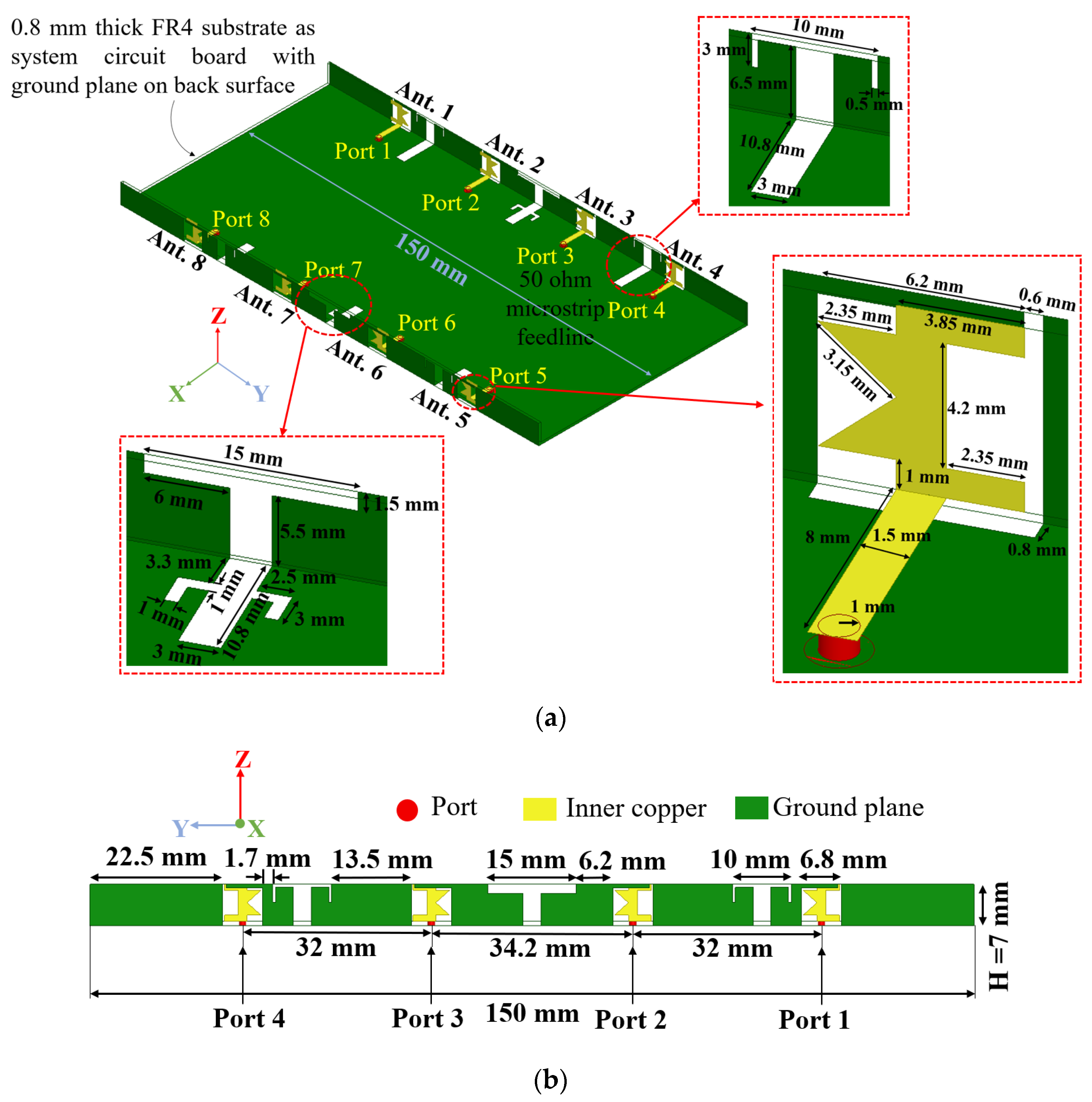
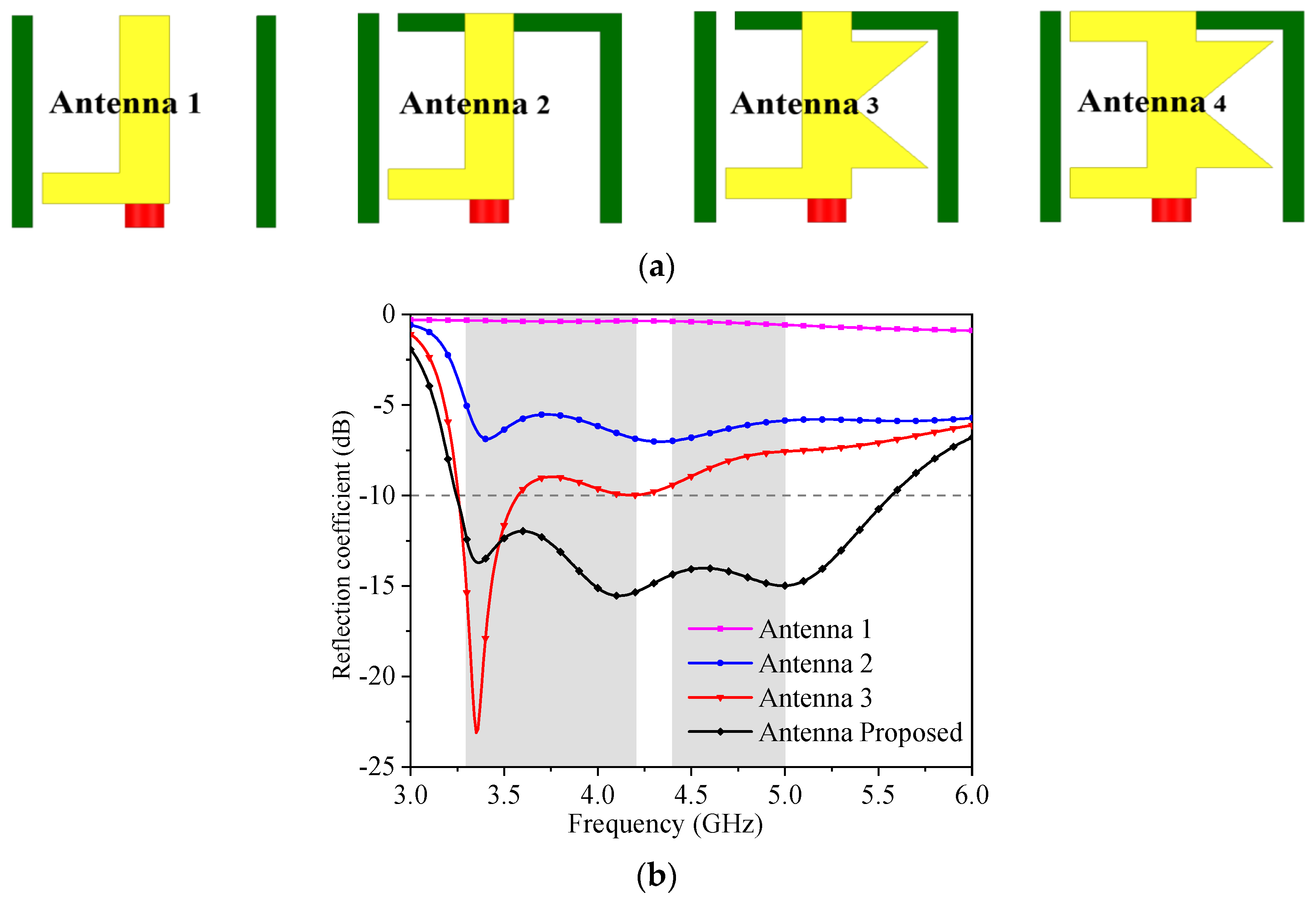

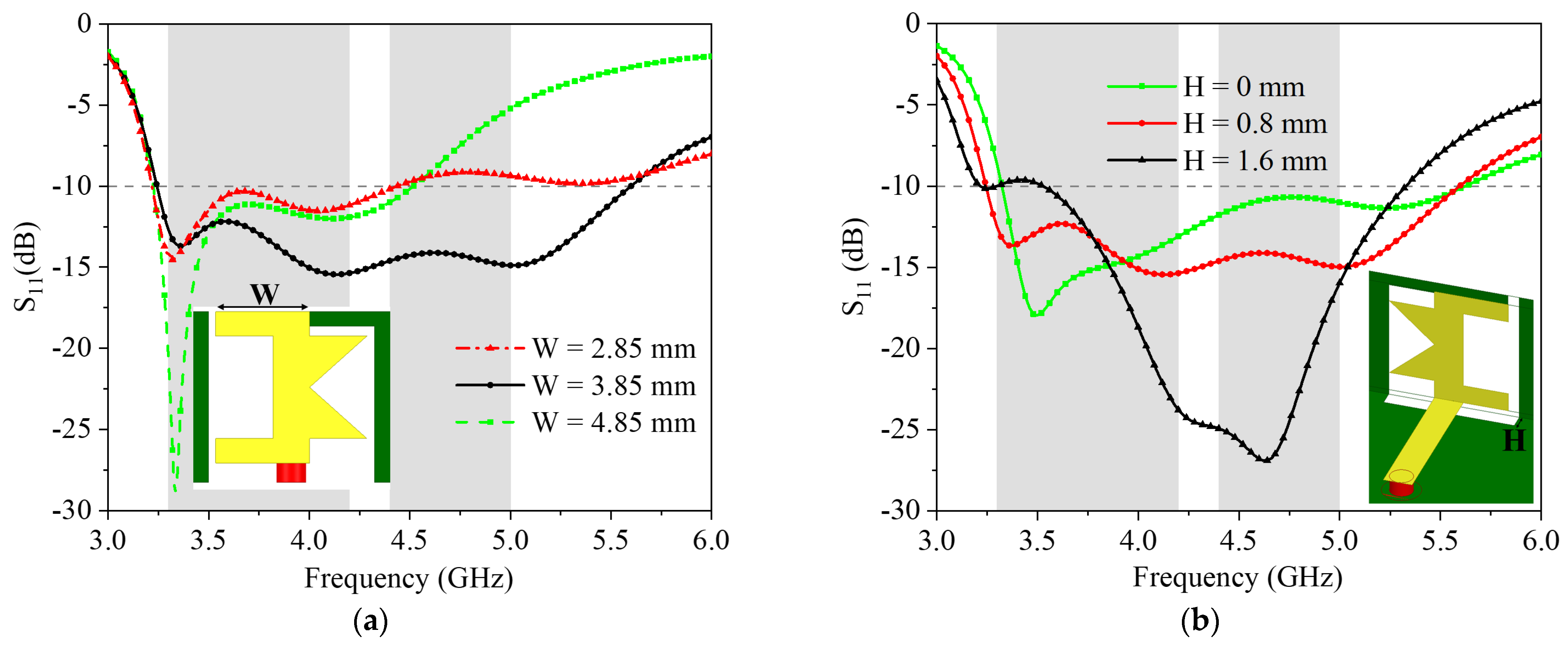

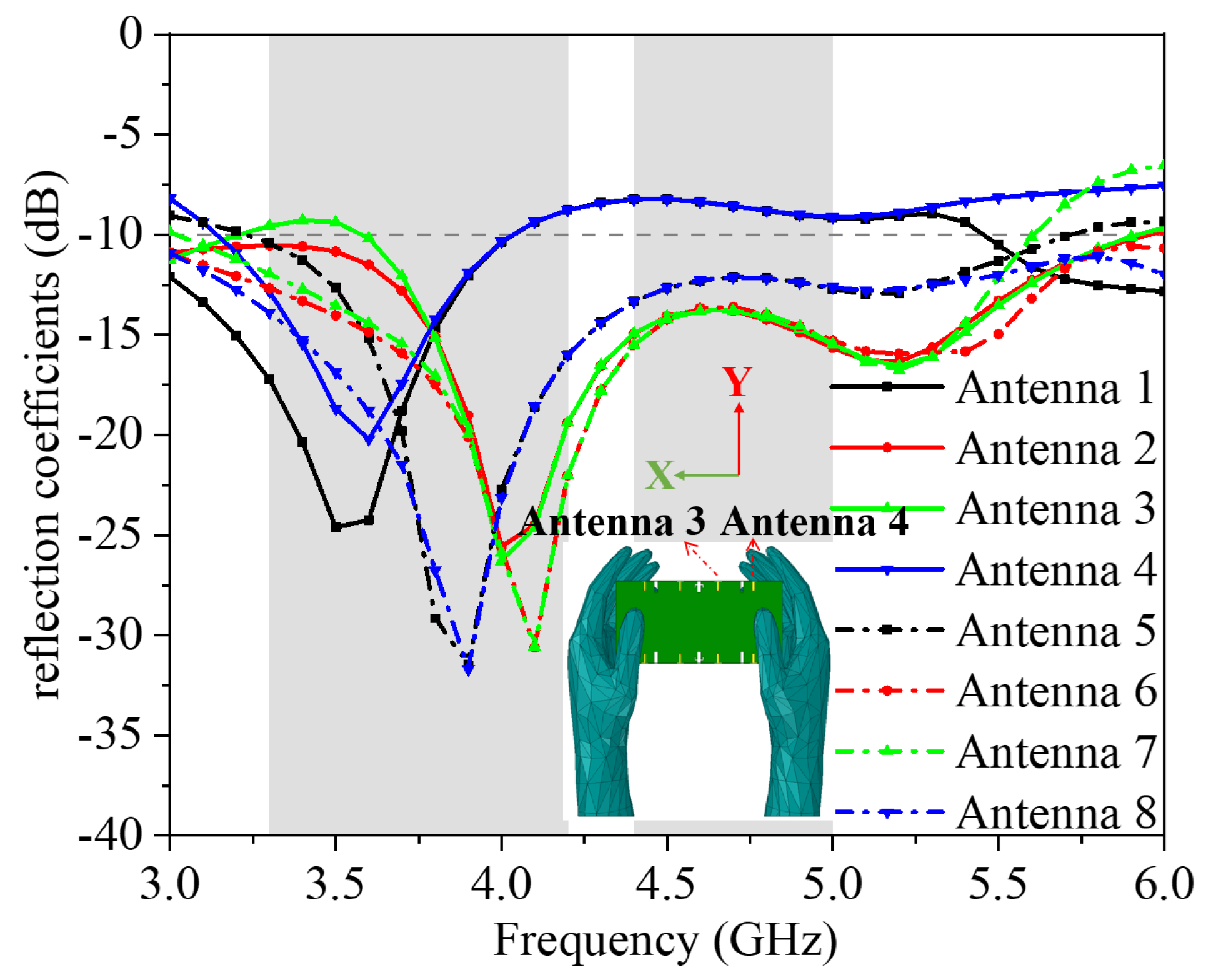


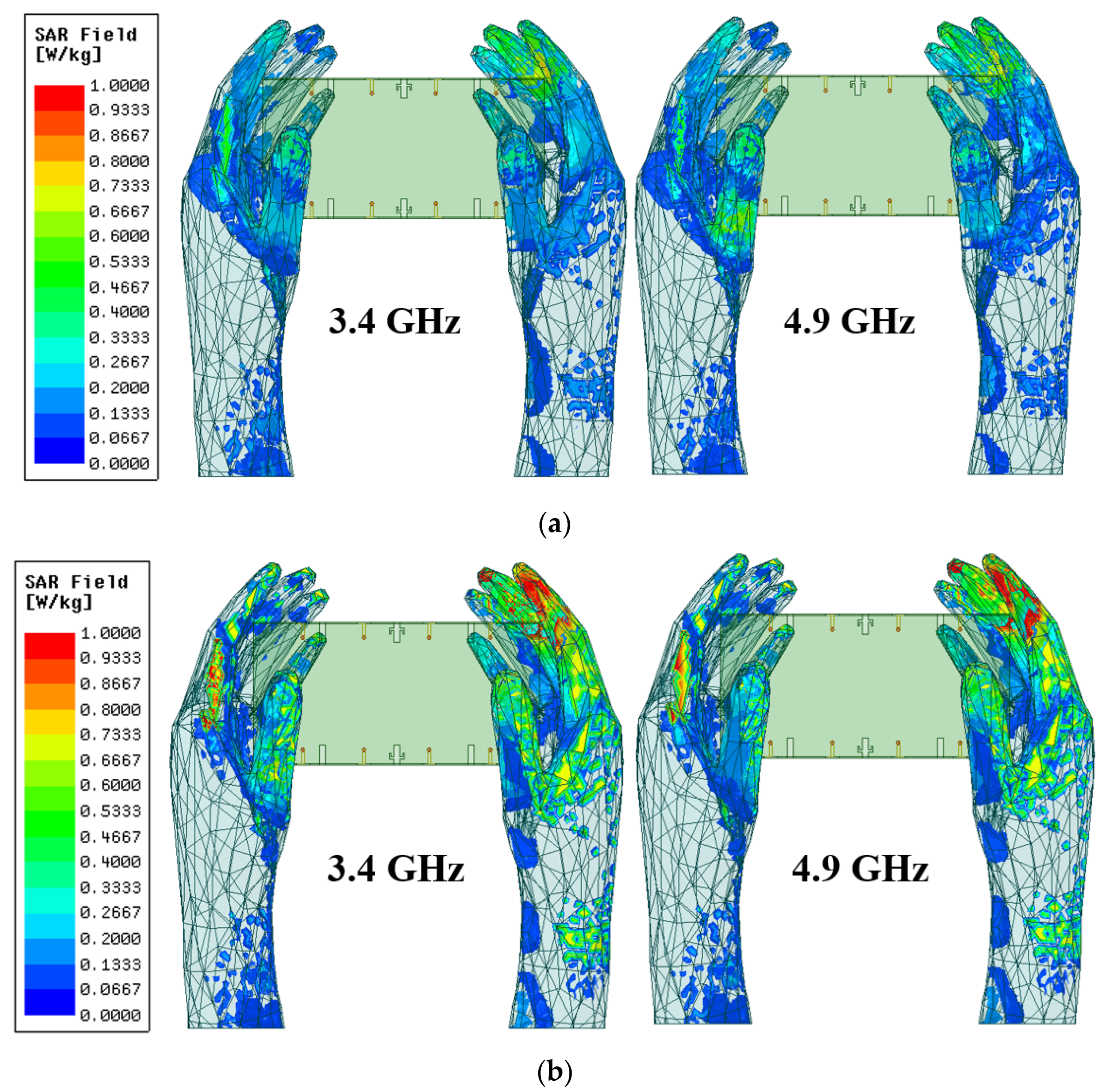

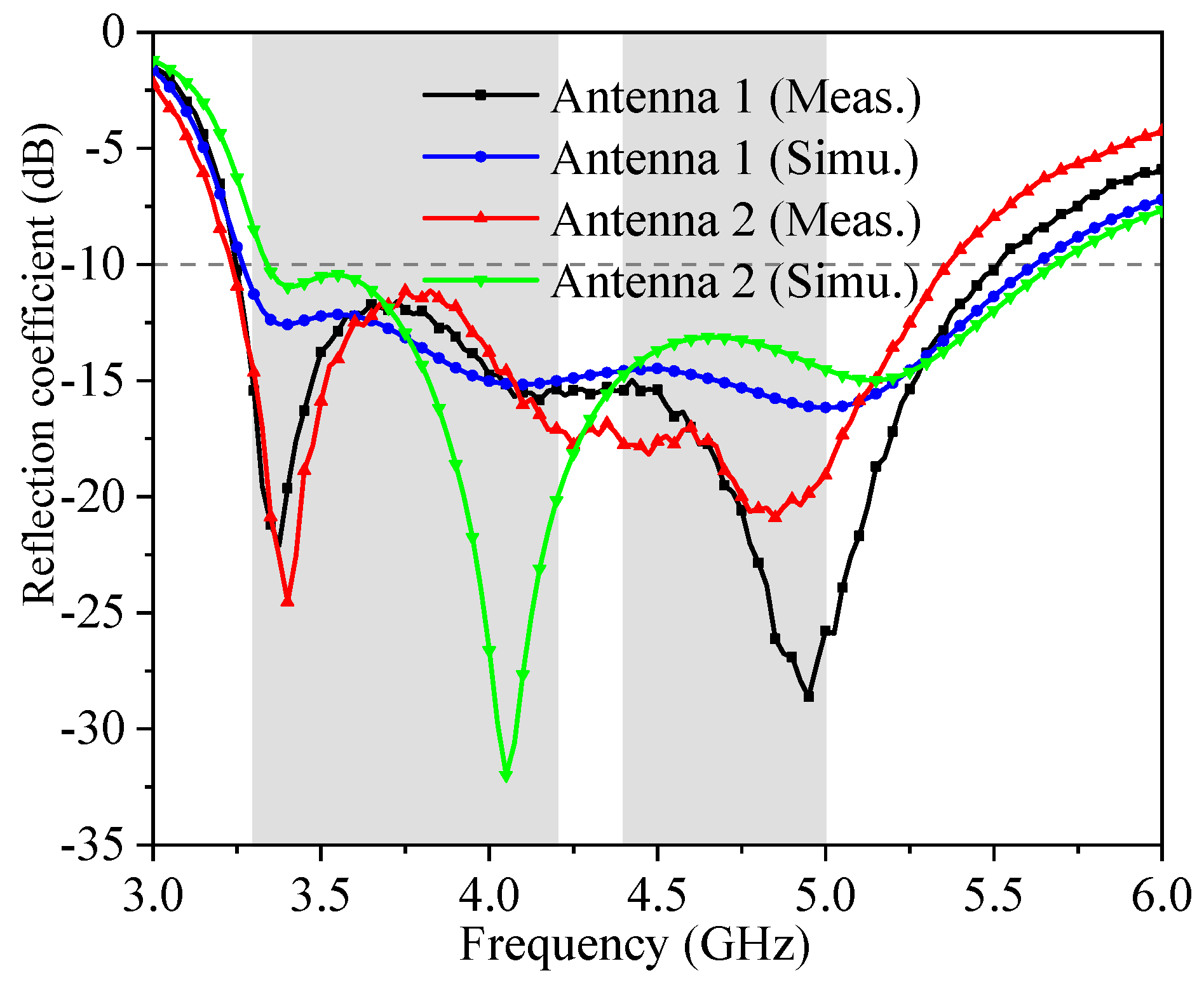
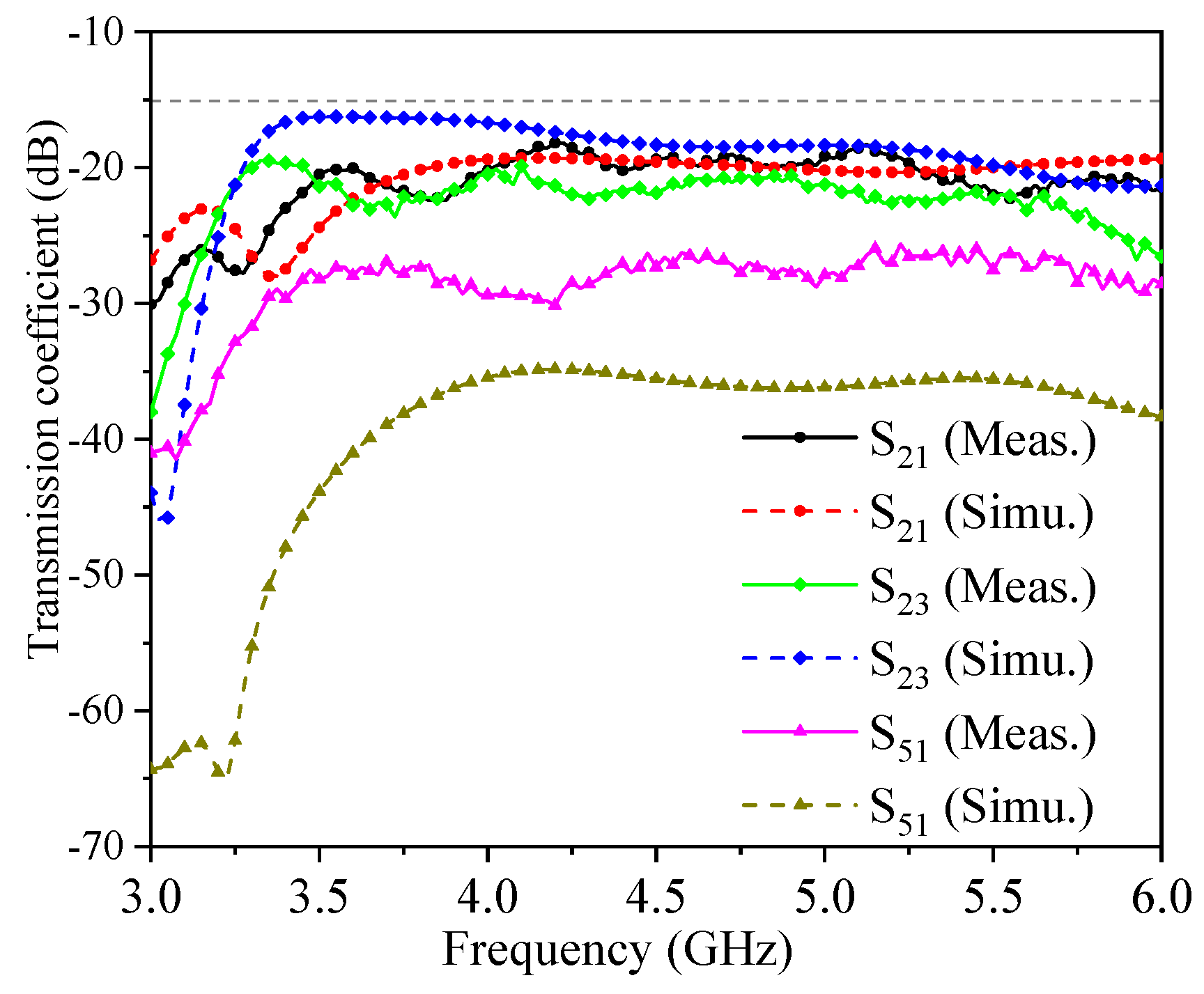


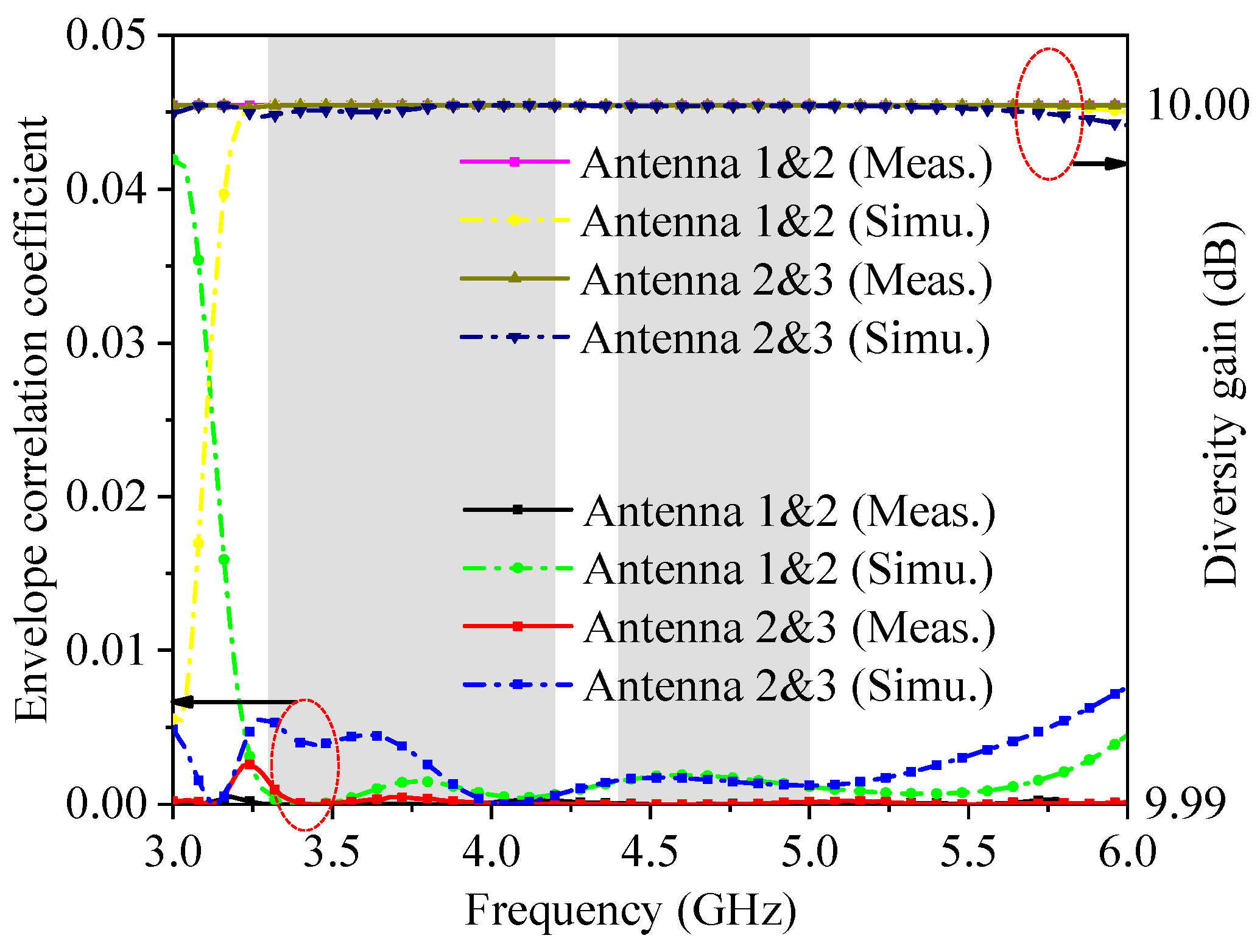


| Reference | Operating Band (GHz) | Isolation (dB) | Total Efficiency (%) | ECC | Size (mm3) |
|---|---|---|---|---|---|
| [1] | 4.37–5.5 | <−22 | 40–50 | <0.068 | 15.6 × 15.6 × 1.6 |
| [5] | 3.25–5.93 | <−10 | 41–69 | <0.1 | 13.9 × 7 × 0.8 |
| [15] | 3.3–4.2 | <−10.5 | 63.1–85.1 | <0.3 | 30 × 7.5 × 2 |
| [17] | 3.3–5.95 | <−15 | 47–78 | <0.11 | 17 × 6 × 0.8 |
| [19] | 3.08–5.15 | <−10 | - | - | 39.75 × 10.5 × 1 |
| [20] | 3.3–5 | <−12 | 31.6–88.6 | <0.11 | 40 × 3 × 7.5 |
| Pro. | 3.3–5.45 | <−18 | >75 | <0.005 | 6.8 × 7 × 0.8 |
Disclaimer/Publisher’s Note: The statements, opinions and data contained in all publications are solely those of the individual author(s) and contributor(s) and not of MDPI and/or the editor(s). MDPI and/or the editor(s) disclaim responsibility for any injury to people or property resulting from any ideas, methods, instructions or products referred to in the content. |
© 2022 by the authors. Licensee MDPI, Basel, Switzerland. This article is an open access article distributed under the terms and conditions of the Creative Commons Attribution (CC BY) license (https://creativecommons.org/licenses/by/4.0/).
Share and Cite
Cai, J.; Zhang, J.; Xi, S.; Huang, J.; Liu, G. A Wideband Eight-Element Antenna with High Isolation for 5G New-Radio Applications. Appl. Sci. 2023, 13, 137. https://doi.org/10.3390/app13010137
Cai J, Zhang J, Xi S, Huang J, Liu G. A Wideband Eight-Element Antenna with High Isolation for 5G New-Radio Applications. Applied Sciences. 2023; 13(1):137. https://doi.org/10.3390/app13010137
Chicago/Turabian StyleCai, Jing, Juhui Zhang, Shuqi Xi, Jianlin Huang, and Gui Liu. 2023. "A Wideband Eight-Element Antenna with High Isolation for 5G New-Radio Applications" Applied Sciences 13, no. 1: 137. https://doi.org/10.3390/app13010137







